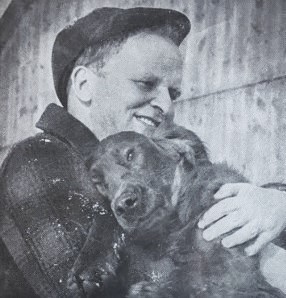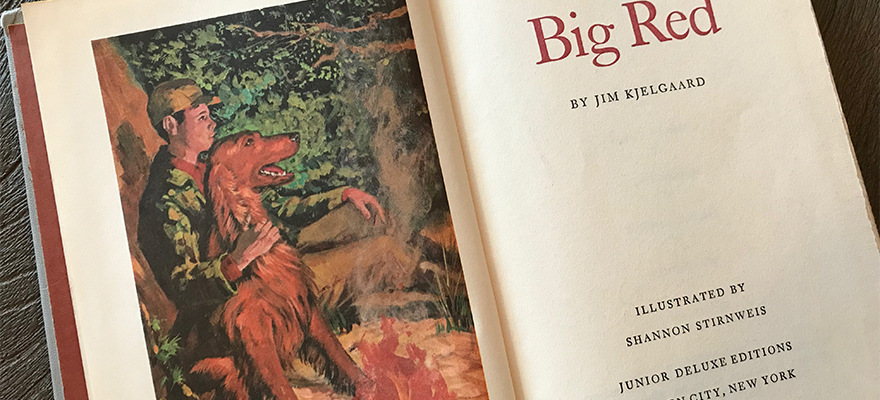Literature
Why your kids should read Jim Kjelgaard
Every boy has a handful of writers who shaped their childhood, and for some reason, most of them are about dogs. There is something about the freedom of a boy and his dog and the fens, forests, and fields that captures the imagination—and one of the very best at capturing that boyhood vision was James Arthur Kjelgaard, known to his reading public (who were all mostly under the age of 14) as Jim. He wrote over forty novels by the time of his death in 1959, and captured something wonderful in the process.
Jim was born in 1910 in New York City, and the America he would spend decades capturing on the page was already disappearing. In 1900, around 40% of Americans lived on farms and 60% lived in rural areas that contained around 7 million farms. By the time of his death in 1959, Americans had relocated en masse to the suburbs, the number of farms had fallen to fewer than 4 million (it is now around 2 million, and almost none are the sort of family farms Kjelgaard wrote about).
Kjelgaard did not set out to capture an American way of life; he was merely writing about his own. One of six children—five boys and a girl—Kjelgaard grew up on a 750-acre farm in the Pennsylvanian Allegheny Mountains, and playing outdoors was default. He and his brother Henry were once treed by a bear, and his backwoods adventures showed up in Buckskin Brigade and others. Kjelgaard was obsessed with reading, and although his family was not well-off, his parents attempted to keep him well-supplied with books at no small sacrifice to themselves.
When the family farm failed and the Kjelgaard tribe moved to Galeton, Kjelgaard began to show interest in writing as well as trapping, fishing, hunting, and, of course, dogs. Around the same time, Kjelgaard was diagnosed with a tumor resulting in epilepsy at Johns Hopkins Hospital in Baltimore, Maryland. His condition did not inhibit his career—which included fiction for magazines such as The Saturday Evening Post and Adventure—but contributed to the chronic pain and severe depression that eventually led, tragically, to his suicide at the age of 48. Some of his books remain in print—Big Red, which was turned into a film by Disney, is the most well-known—but many are now out of print.

Kjelgaard is one of a handful of children’s authors who deserves to be better remembered. There are others who wrote beautifully on similar themes during the same period—Walt Morey (Gentle Ben); Jean Craighead George (My Side of the Mountain); Sterling North (Rascal, The Wolfling); Elizabeth George Speare (The Sign of the Beaver)—but they have largely received their literary due and are, with some exceptions, still widely read. Much of Kjelgaard’s work, like that of the naturalist and wildlife artist Ernest Thompson Seton, is out of print. Fortunately, there are many small publishing houses that are seeking to rectify that. These works are largely in the public domain and thus can be reissued for new generations of readers.
Last year, several friends and I set up a small publishing house for the dual purpose of producing factual resources for Christians on current subjects as well as reprinting classic literature that is lesser known and more difficult to find (many of Kjelgaard’s out of print works can cost well over $50) to make it more easily and affordably available. So far this year, Christian Heritage Press has republished three of Kjelgaard’s beautiful boyhood novels—The Black Fawn, about an orphan boy who moves in with an elderly couple and is introduced to life on the farm and in the forest; Desert Dog, about an abandoned greyhound fighting for survival and a new home; and Rescue Dog of the High Pass, Kjelgaard’s imagining of the first famous St. Bernards (for which I wrote a short historical foreword).
If you’re interested, you can either purchase them at The Bookshop in downtown Norwich, Oxford County, Ontario—or online. We hope to make many more of his works available over the coming months and years, and hope that your children enjoy them as much as I did.











Thanks for this! It is just what little, and big children need in these times. What a joy it is to experience, through a book by Jim Kjelgaard, what it is like to cross a desert area in winter with a family in a horse drawn wagon your only home or to hunt down ‘Old Majesty’ as a boy with a rifle.all alone.
Gratefully, Mary Anne Kjelgaard Sheehy (niece)
Thank you very much!
I just re-read Snow Dog – which I had read to my now 64 yearold son when he was about 6 years old. I still have the book – a bit yellowed but intact. Can’t bear to get rid of it – along with The Call of the Wild – again original.
That one is great, along with Wild Trek!
This mans stories, love for dogs and real life struggles bring tears to my eyes.